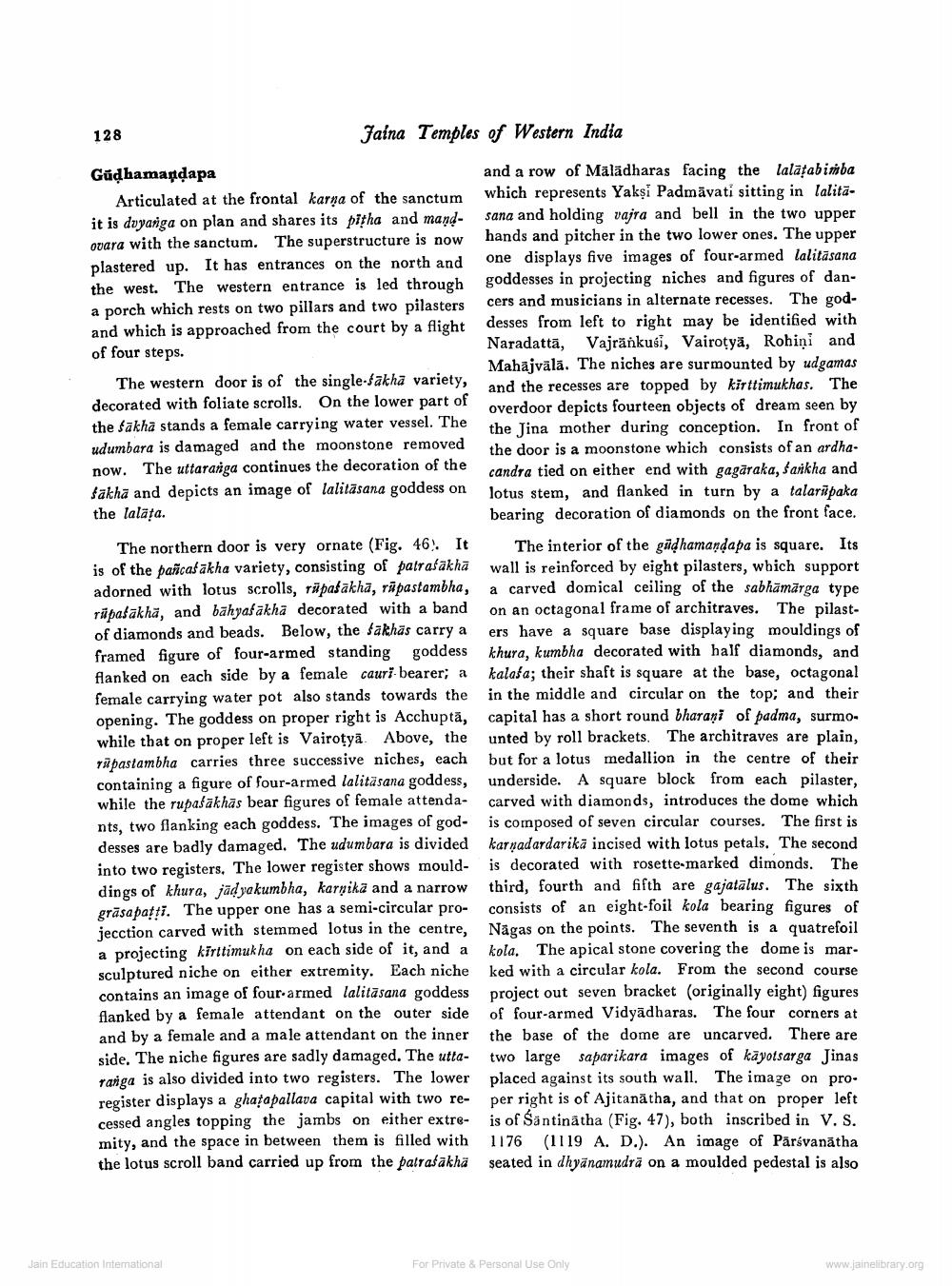________________
128
Faina Temples of Western India
Gúdhamandapa
and a row of Mālädharas facing the lalatabimba Articulated at the frontal karna of the sanctum which represents Yakşi Padmavati sitting in lalitāit is dvyanga on plan and shares its pitha and mand- sana and holding vajta and bell in the two upper ovara with the sanctum. The superstructure is now hands and pitcher in the two lower ones. The upper plastered up. It has entrances on the north and one displays five images of four-armed lalitasana the west. The western entrance is led through goddesses in projecting niches and figures of dana porch which rests on two pillars and two pilasters cers and musicians in alternate recesses. The godand which is approached from the court by a flight desses from left to right may be identified with of four steps.
Naradattā, Vajränkusi, Vairotyä, Rohiņi and
Mahaivāla. The niches are surmounted by udgamas The western door is of the single-fakha variety,
and the recesses are topped by kirttimukhas. The decorated with foliate scrolls. On the lower part of
overdoor depicts fourteen objects of dream seen by the Sakha stands a female carrying water vessel. The
the Jina mother during conception. In front of udumbara is damaged and the moonstone removed the door is a moonstone which consists of an ardha. now. The uttaranga continues the decoration of the
candra tied on either end with gagäraka, Sarikha and fakha and depicts an image of lalitasana goddess on lotus stem, and flanked in turn by a talarípaka the lalața.
bearing decoration of diamonds on the front face. The northern door is very ornate (Fig. 46). It The interior of the gūdhamandapa is square. Its is of the pañcafākha variety, consisting of patrafākhā wall is reinforced by eight pilasters, wbich support adorned with lotus scrolls, räpasākha, rūpastambha, a carved domical ceiling of the sabhāmārga type rūbatakha. and bāhyafakha decorated with a band on an octagonal frame of architraves. The pilastof diamonds and beads. Below, the fathas carry a ers have a square base displaying mouldings of framed figure of four-armed standing goddess khura, kumbha decorated with half diamonds, and flanked on each side by a female cauri-bearer; a kalaša; their shaft is square at the base, octagonal female carrying water pot also stands towards the in the middle and circular on the top; and their opening. The goddess on proper right is Acchuptă, capital has a short round bharași of padma, surmowhile that on proper left is Vairotyä. Above, the unted by roll brackets. The architraves are plain, Tāpastambha carries three successive niches, each but for a lotus medallion in the centre of their containing a figure of four-armed lalitäsana goddess, underside. A square block from each pilaster, while the rupasākhās bear figures of female attenda- carved with diamonds, introduces the dome which nts, two flanking each goddess. The images of god- is composed of seven circular courses. The first is desses are badly damaged. The udumbara is divided karşadardarika incised with lotus petals. The second into two registers. The lower register shows mould- is decorated with rosette-marked dimonds. The dings of khura, jad yakumbha, karnika and a narrow third, fourth and fifth are gajatalus. The sixth grāsapatti. The upper one has a semi-circular pro- consists of an eight-foil kola bearing figures of jecction carved with stemmed lotus in the centre, Nägas on the points. The seventh is a quatrefoil a projecting kiritimukha on each side of it, and a kola. The apical stone covering the dome is marsculptured niche on either extremity. Each niche ked with a circular kola. From the second course contains an image of four-armed lalitāsana goddess project out seven bracket (originally eight) figures flanked by a female attendant on the outer side of four-armed Vidyadharas. The four corners at and by a female and a male attendant on the inner the base of the dome are uncarved. There are side. The niche figures are sadly damaged. The utta- two large saparikara images of kāyotsarga Jinas ranga is also divided into two registers. The lower placed against its south wall. The image on proregister displays a ghatapallava capital with two re- per right is of Ajitanätha, and that on proper left cessed angles topping the jambs on either extre- is of Śäntinātha (Fig. 47), both inscribed in V. S. mity, and the space in between them is filled with 1176 (1119 A. D.). An image of Pärávanātha the lotus scroll band carried up from the patrafakha seated in dhyānamudrā on a moulded pedestal is also
Jain Education Interational
For Private & Personal Use Only
www.jainelibrary.org




